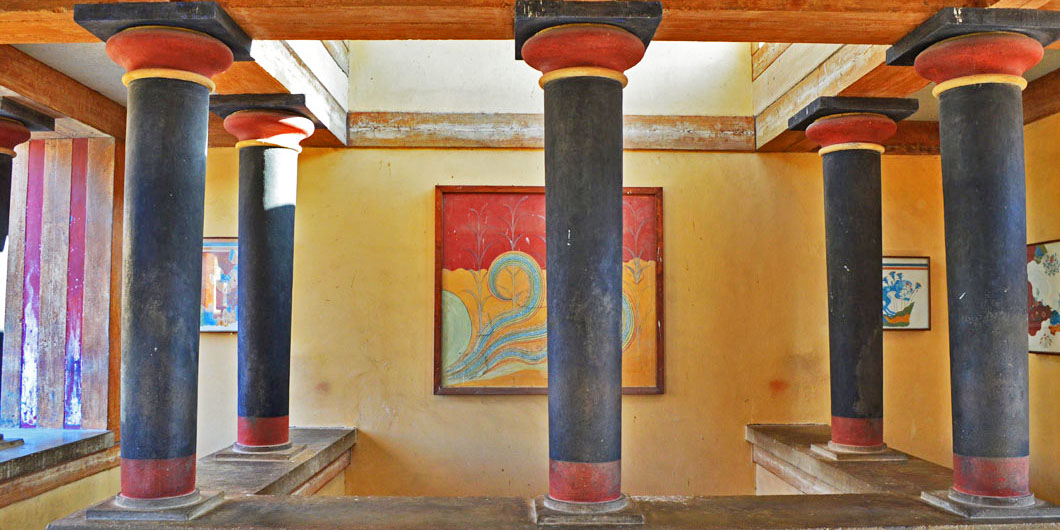Knossos, the largest and most brilliant centre of the Minoan civilization, is located 5 kilometres south of the historical centre of the city of Heraklion. East of the hill where the magnificent ruins of Minoan Knossos are situated, excavations have also brought to light traces of a Neolithic settlement which dates back to 6000 BC.

In the labyrinthine arrangement of corridors and rooms of the palace complex, many scholars have visualised the famous Minoan “Labyrinth”.
In the labyrinthine arrangement of corridors and rooms of the palace complex, many scholars have visualised the famous Minoan “Labyrinth”. Such a notion of the existence of a labyrinth may be only a mythological remembrance of a great civilization, however one could say that it really does correspond to the architectural structure which can be seen today in Knossos.
Twisting corridors and stairwells which used to connect as many as five storeys, create a truly labyrinthine complex. There, visitors can admire important architectural innovations, such as water supply systems and sewer networks, shafts for the lighting and ventilation of the lower levels of the palace complex, and rooms equipped with baths and sanitary facilities that almost match modern constructions in ingenuity and function.
Round the central courtyard one can see spaces designed for public and religious ceremonies, as well as storerooms, workshops, residences, smaller courts, connecting hallways etc, located in different buildings (depending on function), which all add to the complexity of the palace.

The most important fact about the palace complex of Knossos is that an expert scholar of our time can trace in its structure a well-defined urban centre, which developed around a large courtyard.
It is believed that the first palace complex of Knossos was probably built in the 19th century BC and was destroyed in the 17th century BC. It was later rebuilt (16th century BC) in a remarkable, functional way, as one can ascertain by seeing the surviving ruins. In the mid 15th century BC, Knossos is believed to have reached its acme, which lasted until approximately 1450 BC; then, an extensive natural disaster occurred, probably due to an eruption of the volcano of Santorini(known as the “Thera eruption”). A brief period of flourishing followed when the Mycenaeans conquered Crete. However, from 1400 BC and on it no longer existed as a palace, yet up until 1150 BC various other activities were conducted there. Subsequently, it was completely deserted.
From the great palace complex of Minoan Knossos, the legend of king Minos survived in the Hellenic years, while in the 19th century it inspired the first organised attempt of excavation, which was made in 1878 by the Heraklion local Minos Kalokairinos. However, the person who eventually brought the ruins of Knossos to light, in their entirety, was the English archaeologist Sir Arthur Evans. He began his systematic excavations in 1900, and his work lasted until 1931.

During these thirty years, earlier phases of the palace complex were also unearthed in their entirety, and remarkable finds of various periods of occupation were discovered. Sir Arthur Evans, along with his systematic excavation, also attempted a partial restoration of the palace, using materials of his time; in some cases, he even proceeded in reconstructing entire sections of the complex, making interventions that are clearly visible today.
Certain scientists believe that these were excessively invasive, while others argue that they were not arbitrary and that his restoration works represent what the palace must have looked like, to a certain extent, in its day of prosperity.
1st April - 31st August
08:00 – 20:00 (Last entry 19:30)
1st - 15th September
08:00 – 19:30 (Last entry 19:00)
16th - 30th September
08:00 – 19:00 (Last entry 18:30)
1st - 15th October
08:00 – 18:30 (Last entry 18:00)
16th - 31st October
08:00 – 18:00 (Last entry 17:30)
























